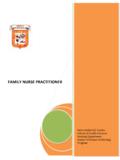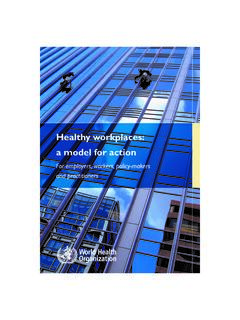Transcription of The Role of the Occupational Health Nurse in Workplace ...
1 The Role of the Occupational Health Nurse in Workplace Health Management WHO Regional Office for Europe Copenhagen EUR/01/5025463 ABSTRACT This document describes the role of the Occupational Health Nurse in Europe, and whilst recognizing the wide variation that exists in Occupational Health nursing practice between different countries this document reflects the standards that have already been achieved in those countries where Occupational Health nursing is at its most advanced. Within the WHO European Member States the discipline of Occupational Health is undergoing rapid development. This is largely due to the new demands and expectations from employers, employees and their representative bodies as they recognize the economic, social and Health benefits achieved by providing these services at the Workplace . The rapid development of Occupational Health services has also, in part, been driven by the expanding program of EU legislation in the areas of Health , safety and environmental protection and the need by employers to respond to this legislation.
2 In addition Occupational Health services, provided at the Workplace to address the Health care needs of working populations have been identified as an important component of the public Health strategy. These services can also make a significant contribution to other government initiatives, such as; reducing Health inequalities, reducing social exclusion and sickness absence, and by protecting and promoting the Health of the working population Occupational Health services can help to reduce the overall burden of ill Health in Europe. Occupational Health nurses, as the largest single group of Health care professionals involved in delivering Health care at the Workplace , have responded to these new challenges. They have raised the standards of their professional education and training, modernized and expanded their role at the Workplace , and in many situations have emerged as the central key figure involved in delivering high quality Occupational Health services to the working populations of Europe.
3 Occupational Health nurses, working independently or as part of a larger multiprofessional team, are at the frontline in helping to protect and promote the Health of working populations. Keywords Occupational Health NURSING Workplace Health POLICY trends EDUCATION NURSING EUROPE World Health Organization 2001 All rights in this document are reserved by the WHO Regional Office for Europe. The document may nevertheless be freely reviewed, abstracted, reproduced or translated into any other language (but not for sale or for use in conjunction with commercial purposes) provided that full acknowledgement is given to the source. For the use of the WHO emblem, permission must be sought from the WHO Regional Office. Any translation should include the words: The translator of this document is responsible for the accuracy of the translation. The Regional Office would appreciate receiving three copies of any translation.
4 Any views expressed by named authors are solely the responsibility of those authors. This document was text processed in Health Documentation Services WHO Regional Office for Europe, Copenhagen Target audience for this document includes: Policy-makers in the Ministries of Health , Education, Labour, Employment, and Environment as well as Workplace Health practitioners in Public Health , Health and Safety, and Economic Development institutions within WHO European Member States. Employers and employees and their representative bodies. The document will also be of interest to purchasers and providers of Occupational Health services, Occupational Health nurses, educators and other specialists in the field of Occupational Health . Editors Stuart Whitaker and Boguslaw Baranski Contributors to the report present at the WHO workshop held on 11-12 November 1999 in Bilthoven, Netherlands Ms.
5 Frances Baker, Former President, The Federation of Occupational Health Nurses within the European Union (FOHNEU), West Lothian, United Kingdom Dr. Boguslaw Baranski, Regional Adviser, Healthy Workplaces, WHO Regional Office for Europe, Copenhagen, Denmark Ms. Harriet Corin, Education Planner, The Deaconia Polytechnics, Helsinki, Finland Mr. Jan van Delft, Coordinator, Course for Occupational Health Nurses, Nijmegen Hogeschool, Nijmegen, The Netherlands Ms. Filipina van Dorpe, Flemish Nurses Association, Antwerp, Belgium Ms. Christina Ekeberg, Senior Training Officer in Occupational Health , Education and Training of Occupational Health Nurses, National Institute for Working Life, Stockholm, Sweden Ms. Janine Fanchette, Coordinator of Inter University Diploma Occupational Health Nurse Qualification, Department of Occupational Health , University of Strasbourg, France Ms Mirjam de Groot, Dutch Association of Occupational Health Nurses, Overberg, The Netherlands Mr.
6 Geert van Gent, Director, Total Hazard and Quality Management, Venlo, The Netherlands Ms. Bernadette Jackson, Chief Civilian Nursing Officer, Ministry of Defence, London and Chair, Occupational Health Managers Forum, Royal College of Nursing, London, United Kingdom Ms. Annette Jorgensen, Manager, Occupational Health Centre of the Runestone, Malm , Sweden Ms. Katariina Keinanen, Tampereen Ty terveys RY, Tampere, Finland Mr. R. Marg s, Dutch Association of Occupational Health Nurses, Overberg, The Netherlands Ms. Nora Nyberg, Tampereen Ty terveys RY, Tampere, Finland Ms. Marjatta Perttila, Occupational Health Nursing Educator, Faculty of Social and Health Care, Lahti Polytechnic, Lahti, Finland Ms. Julie Staun, Manager, Occupational Health Service, Haldor Tops e Concern Denmark and President, The Federation of Occupational Health Nurses within the European Union (FOHNEU), Jaegerspris, Denmark Mr.
7 Dirk Vermeulen, Medimar and Flemish Nurses Association, Antwerp Belgium Dr. Stuart Whitaker, Senior Research Fellow, Head of Health Services Research Unit, Institute of Occupational Health , University of Birmingham, United Kingdom Dr. Zaprian Zaprianov, Senior Researcher and Associate Professor, National Centre of Hygiene Medical Ecology and Nutrition, Sofia, Bulgaria Secretariat Ms Pratima Purnaiya, WHO European Centre for Environment and Health , Bilthoven Division, Netherlands CONTENTS Page 1. Changing nature of working life and the new The need for improved Workplace Health The role of the World Health Organization and International Labour The London Declaration - a new political 2. Workplace Health The Healthy Workplace setting - a cornerstone of the Community Action The Healthy Community 3. New Workplace Health Key steps in developing Workplace Health Key steps in dimplementing Workplace Health 4.
8 Key benefits of Workplace Health 5. The development of multiprofessional Occupational Health The Occupational Health Nursing 6. Role of the Occupational Health Nurse in Workplace Health The Occupational Health Nurse as a unique frontliner ..27 Variation in roles of Occupational Health nurses within member 7. Core areas of knowledge and Health 8. Guidance on determining the function of an Occupational Health 9. Evaluation of 10. Education and training of Occupational Health Annex I Professional associations active in Occupational Health Annex II Federation of Occupational Health Nurses within the European Annex III List of Occupational Health nursing associations affiliated to the Federation of Occupational Health Nurses in the European i Foreword The Occupational Health services, provided by employers or governmental authorities in all countries of the WHO European Region to address the Health promotion, Health protection and Health care needs of working populations have been identified as an important component of the public Health system.
9 These services can make a significant contribution to essential governmental initiatives, such as; increasing Health equality, improving social cohesion, and reducing sickness absence. They help to reduce the overall burden of diseases in Europe. The rapid development of Workplace Health protective and preventive services has been driven by the WHO strategies and recommendations, the conventions of ILO as well as by the European Union legislation in the areas of Health and safety at work and by the European Commission programme in public Health . This was also largely due to the new demands and expectations from employers, employees and their representative bodies as they recognize the economic, social and Health benefits achieved by providing these services at the Workplace . These services provide the available knowledge and evidence necessary for the continuous improvement of Workplace Health management, but they also participate in this process.
10 Comprehensive Workplace Health management is a process involving all stakeholders inside and outside the enterprise. It aims at empowering them to take control over their own Health and their family s Health considering environmental, lifestyle, Occupational and social Health determinants and quality of Health care. It is based on Health promotion principles and it creates a great challenge to Health , environment and safety professionals providing services, advice, information and education to social partners at work. It involves also taking care of considerable socioeconomic interest of all involved stakeholders. It has been shown in several instances that the enterprises acting on the well-regulated market can gain competitive advantage by: Protecting human Health against Health and safety hazards occurring in the work environment ii Promoting human Health , workplaces for all ages and healthy aging by appropriate work culture, work organization and support to social cohesion Promoting mental Health , healthy life style and preventing major non-communicable diseases using specific Workplace Health policies and management tools Maintaining work ability thus also employability throughout working life Reducing Health care costs caused by employees and employers injuries, diseases, illnesses and premature retirement resulting from or influenced by Occupational , environmental, life style and social Health determinants Using resources effectively and efficiently and protecting the natural environment and creating Health supportive environment.
















